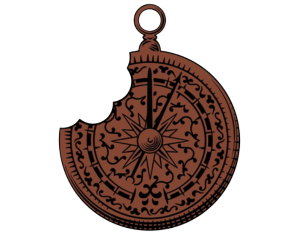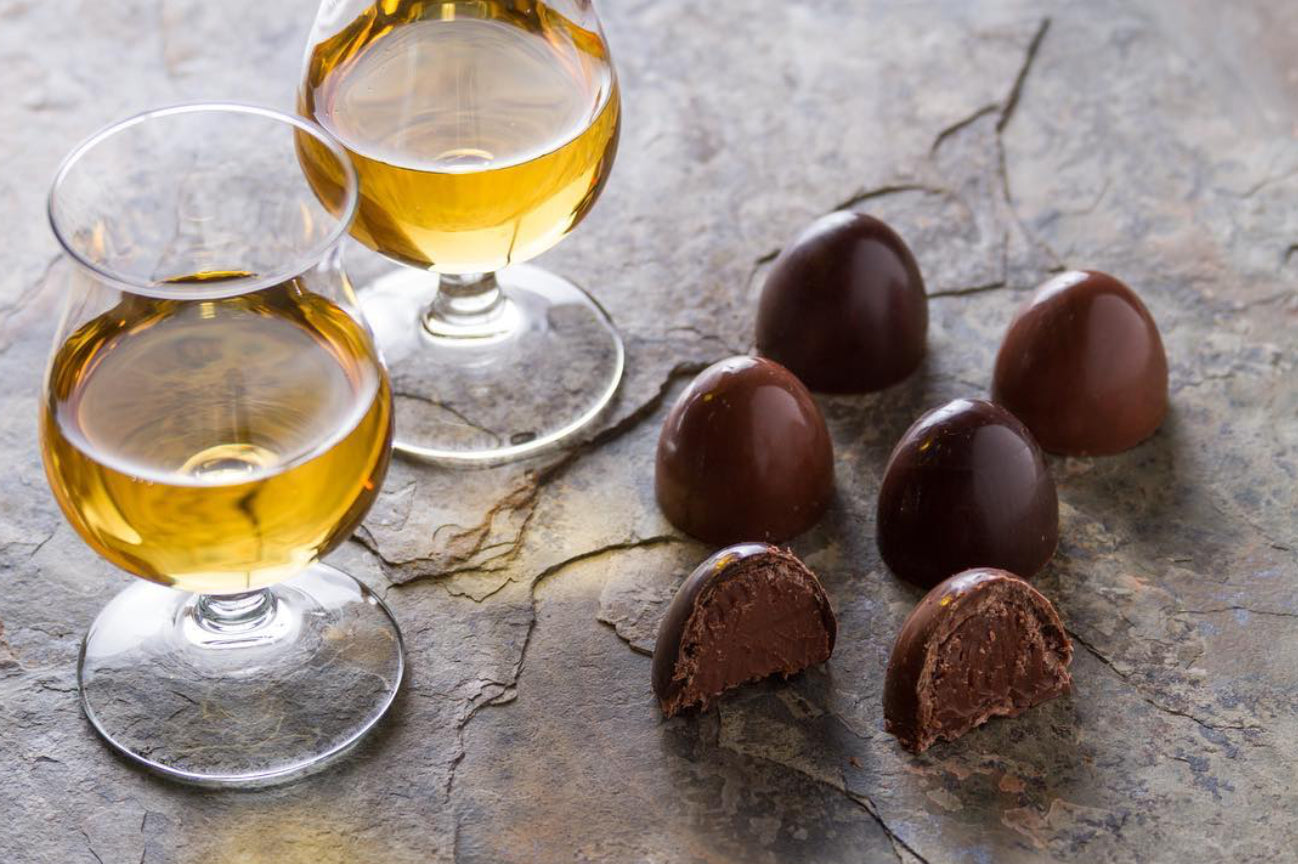Chocolate & Cognac

“I meditate, I do yoga, and I have a lot of friends who are healers...And if none of that works, I go buy a chocolate bar and a bottle of cognac.”
- Susan Strasberg
I am made of chocolate. I’m convinced that it runs through my veins, leaving happy little chocolate covered cells in its wake. Perhaps that’s why I understand Susan so well. I, too, meditate, do yoga and even possess my own certifications in various healing arts. I’ve noticed that all these practices seem to work even better for me when I pair them with a square or two of exquisite chocolate.
Now, I can’t tell you why, but of all the spirits I’m exploring in this pairing series, cognac is the one that has tapped me on the shoulder and said, “I would really like to play with you and your fancy chocolate.” Perhaps while she walked this earth, Susan received a similar shoulder tap, too. Therefore, in the spirit of spirits, I offer a toast to a rich old friend, a new French acquaintance, and an open mind and mouth!
Victor Hugo referred to cognac as “liquor of the gods,” and Swedish botanist Carolus Linnaeus named the chocolate tree Theobrama cacao or “food of the gods.” It follows logic, then, that these two divine substances should be savored side by side. Some cognacs even have chocolate notes along with flavors of fruit, flowers and spices.
So, what exactly is cognac? Cognac is a noble spirit made from the fermented, distilled and aged juice of specific white grapes (usually Ugni Blanc and Folle Blanche), that are low in sugar and high in acidity. A highly acidic grape typically has the potential to age well. All cognac is brandy, but not all brandy is cognac, much in the same way that all champagne is sparkling wine, but not all sparkling wine is champagne.
There are strict guidelines and methods regulated by the Appellation d’Origine Controlee, (or A.O.C.), that cognac makers must follow. Cognac must hail from the Cognac region, located in the southwest portion of France, while brandy can be made anywhere in the world. All cognac has been twice distilled, and post-distillation, the liquid is referred to as eau de vie, or “water of life.” The true magic of cognac happens in French oak barrels during the intricate two (or more) year aging process, where tannins come to the fore. As the eau de vie ages, it develops backbone and takes on a range of complex flavors from the surrounding air and wood, ripening into deeper complexity.
While other spirits age in a single barrel, eau de vie develops its unique characteristics in three distinct oak barrels. For the first six to twelve months, the distillate begins its aging process in a “new” oak barrel which imparts spicy aromas. “New” doesn’t necessarily mean brand new when it comes to cognac; a new barrel is one that has been used for three years or fewer. The second barrel is an older, seasoned cask that will provide the cognac with added texture, suppleness and dimension. At ten to twenty years old, the final barrel bestows exceptional refinement upon the cognac.
The length of time that the cognac ages in French oak barrels determines the exclusive distinction or grade it receives on its label. The grades used to market cognac based on age are:
- V.S. (Very Special) or *** (three stars): aged at least two years
- V.S.O.P. (Very Special Old Pale): aged at least 4 years
- Napoleon or X.O. (Extra Old): aged at least ten years (formerly six, prior to 2018)
The older the cognac, the more expensive it will be, but a higher price is not necessarily the mark of a more delicious product. Cognac, like chocolate, is a subjective experience. One taster might prefer a V.S.O.P. while another might prefer an X.O. Also, the characteristic notes of the chocolate you choose will help determine which cognac would pair most harmoniously with it.
Before I serve up pairing suggestions, I offer you a brief history of cognac and brandy...
Cognac was created out of necessity and ingenuity in the 16th century when Dutch merchants traveled to France to purchase salt, wood, and wine. They realized that if they distilled wine into eau de vie, they could maximize its quality while effectively preserving it to withstand the long sea journey home. Distillation made the drink far more palatable, so the merchants decided to experiment with distilling twice, which is what distinguished it as brandy. The second distillation, they discovered, created an even tastier drink. The name brandy comes from the Dutch word brandewijn which translates to “burnt wine.”
Here’s what I suggest for pairing…
With a Cognac VS, you’ll be delighted with the deep, rich and creamy Castronovo 63% Colombia Sierra Nevada Dark Milk. If you prefer a bar with some texture, choose Soma’s Milk Old School which is nothing short of blissful. These complex milk chocolate bars are rich, resonant, soft and comforting all at once. They have a pleasant mellowing effect on the VS Cognac.
Cognac VSOP is incredibly lovely with any of these utterly satisfying dark chocolates: Fruition Dominican Los Bejucos 77%, Soma Porcelana Venezuela 70%, or KahKow’s La Esmeralda 67%, or Qantu's Chuncho 70%.
Cognac XO is the Rolls Royce of cognacs. It will pair wonderfully with any of the chocolates I suggested for the VSOP, as well as Castronovo Arhuacos 80% or the extremely elegant and sophisticated To’ak Galapagos Harvest 2018 75% dark chocolate.
Follow these steps for the ultimate chocolate and cognac experience:
Serve the cognac neat. Serving it on ice will dull the flavor of both the cognac and the chocolate, and ice numbs the palate, so even water with ice as a beverage is not recommended for intentional chocolate appreciation.
How to Savor Chocolate with Cognac:
Taste the chocolate by itself. Notice the aroma and flavor notes.
Cleanse your palate with a plain cracker, piece of crusty bread, or a thin wedge of tart green apple.
Now taste the cognac by itself, paying attention to its aroma, texture and flavor.
Take another taste of the chocolate, biting into it and then allowing it to melt slightly in your mouth. This can take anywhere from 5-10 seconds.
Take a sip of the cognac as the chocolate continues its melting process. Notice the commingled flavors and sensations in your mouth and body as you unite these two distinct tastes.
Swallow the cognac while the melting process of the chocolate is still underway, and marvel at the unique flavor arc that blossoms and unfolds in your mouth. Enjoy the full effect as the chocolate completely melts.
I hope you share my belief that the whole point of chocolate is sheer, unadulterated pleasure. Susan Strasberg’s quote suggests that chocolate and cognac are a guilty pleasure to which she abjectly submits when loftier practices fail her. Pleasure obscured by cloud cover becomes lackluster, and dare I say, vanilla.
You are free to choose spirituality or healing practices in lieu of pleasure if you like, but I’m here to tell you that playing with chocolate does not have to be a zero sum game. There’s no need to turn in your meditation cushion just because you enjoy indulging your senses. In fact, as a chocolate sommelier, I encourage people to honor their senses so that savoring sumptuous chocolate becomes the meditation. You absolutely can have it all! Chant “om” while you nibble a square of Omnom Chocolate. Your yoga mat can just as effectively double as a place mat. Why not combine chocolate, meditation, cognac and yoga all in a way that feels beautifully balanced and celebratory?
Chocolate traveler, there are many paths to enlightenment, and if you choose to sip and savor on your quest, please know that within the Barometer Chocolate community you’ll find many kindred spirits!
0 comments



